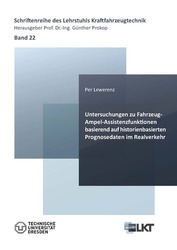| Departments | |
|---|---|
| Book Series (96) |
1378
|
| Nachhaltigkeit |
3
|
| Gesundheitswesen |
1
|
| Humanities |
2363
|
| Natural Sciences |
5406
|
| Engineering |
1791
|
| Engineering | 292 |
| Mechanical and process engineering | 861 |
| Electrical engineering | 686 |
| Mining and metallurgy | 30 |
| Architecture and civil engineering | 75 |
| Common |
98
|
|
Leitlinien Unfallchirurgie
5. Auflage bestellen |
|
Advanced Search
Untersuchungen zu Fahrzeug-Ampel-Assistenzfunktionen basierend auf historienbasierten Prognosedaten im Realverkehr (Volume 22) (English shop)
Per Lewerenz (Author)Preview
Extract, PDF (120 KB)
Table of Contents, PDF (74 KB)
In Bezug auf die Reichweite sind die menschlichen Wahrnehmungsorgane begrenzt, was zu einem Informationsmangel für die Fahrer motorisierter Verkehrssysteme führt. Dieses Defizit kann durch Kommunikationssysteme von Fahrzeug zu Fahrzeug (V2V) und / oder Fahrzeug zu Infrastruktur (V2I) ausgeglichen werden. Mit dem Ziel einer vorteilhaften Kombination der menschlichen Vorteile mit denen technischer Systeme können vernetzte Assistenzsysteme fehlende Informationen liefern, die der Fahrer bei der Situationsbewertung berücksichtigen kann.
Die Annäherung an Lichtsignalanlagen ist eine Verkehrssituation, die häufig von einem Mangel an Informationen durch den Fahrer begleitet wird. Der Fahrer benötigt Informationen über die bevorstehenden Signalzustände, damit er sein Fahrverhalten optimal an die Situation anpassen kann. Bevorstehende Signalzustände verkehrsabhängiger Lichtsignalsysteme können – mit unterschiedlichen Detaillierungsgraden – vorhergesagt und dem Fahrer in vernetzten Fahrzeugen zur Verfügung gestellt werden.
Es bleibt die Frage, ob der menschliche Fahrer auch unsichere vorhergesagte Informationen in die Situationsbewertung einbezieht, da eine detaillierte Prognose Anforderungen an die Infrastruktur stellt, die heute oft nicht erfüllt werden.
Ziel der vorliegenden Arbeit ist die prototypische Implementierung und Untersuchung eines vernetzten Assistenzsystems, das dem Fahrer eine Geschwindigkeitsempfehlung bei Annäherung an Lichtsignalanlagen gibt. Die Empfehlung wird durch einen Vorhersagealgorithmus berechnet, der ausschließlich auf den Beobachtungen der vergangenen Signalzustände aufbaut.
Der Nutzen des Assistenzsystems wird anhand experimenteller Studien im realen Dresdner Verkehr untersucht und anhand der Bewertung sowohl der Messung von Fahrzeugzuständen als auch der subjektiven Systembewertung durch die Testpersonen quantifiziert.
Da der Grad der Unsicherheit aufgrund der Darstellungsform nachvollziehbar ist, bewerteten die Probanden die Informationen trotzdem als eindeutig. Die Auswertung der Ergebnisse zeigt, dass die Testpersonen die Informationen vorteilhaft in ihre Situationsbewertung einbeziehen können, indem sie aufgrund der Geschwindigkeitsanpassung auch bei unsicherer Prognose rund 11% Energie einsparen.
Regarding the range, the human perception organs are limited, which leads to a lack of information for the drivers of motorized transport systems. This deficit can be compensated by the unrestricted range of vehicle to vehicle (V2V) and / or vehicle to infrastructure (V2I) communication systems. With the aim of a beneficial combination of the human advantages with those of technical systems, connected assistance systems can provide missing information, which the driver can take into account for the assessment of the situation.
Approaching traffic lights is a traffic situation, which often brings an information deficiency on behalf of the driver. The driver is in need of information about the upcoming signal status so that he can adapt his driving behavior to the situation optimally. Upcoming signal status of traffic-dependent light signal systems can be predicted – with different levels of detail – and provided to the driver in connected vehicles.
The question remains whether the human driver also incorporates uncertain information predictions into the situation assessment, as a detailed prognosis sets demands on the infrastructure which are often not met today.
The aim of the present work is the prototypical implementation and investigation of a connected assistance system, which gives the driver a speed recommendation when approaching traffic lights. The recommendation is calculated by a prediction algorithm that is exclusively based on the observations of the past signal states.
The benefit of the assistance system is investigated on the basis of experimental studies in the actual traffic of Dresden and is quantified based on the evaluation of both the measurement of vehicle condition as well as the subjective system assessment by the test subjects.
Since the grade of uncertainty is comprehensible due to the form of presentation, the subjects rated the information despite this as unambiguous. The evaluation of the results shows that the test subjects can incorporate the information into their situation assessment advantageously by saving around 11% of energy due to the speed adaption even in case of an uncertain prognosis.
| ISBN-13 (Hard Copy) | 9783736976313 |
| ISBN-13 (eBook) | 9783736966314 |
| Final Book Format | A5 |
| Language | German |
| Page Number | 162 |
| Lamination of Cover | matt |
| Edition | 1. |
| Book Series | Schriftenreihe des Lehrstuhls Kraftfahrzeugtechnik |
| Volume | 22 |
| Publication Place | Göttingen |
| Place of Dissertation | Dresden |
| Publication Date | 2022-06-22 |
| General Categorization | Dissertation |
| Departments |
Engineering
Mechanical and process engineering Automotive engineering |
| Keywords | Ampelassistenz, traffic light assistance, Annäherungsgeschwindigkeit, approach speed, Datenübertragung, data transmission, Digitale Karte, digital map, Echtzeitberechnung, real-time calculation, Emissionen, emissions, Energiebedarf, energy demand, Energieeffizienz, energy efficiency, Fahraufgabe, driving task, Fahrerassistenz, driver assistance, Fahrerverhalten, driver behavior, Fahrleistung, driving performance, Fahrsimulator, driving simulator, Fahrzeug-Ampel-Kommunikation, vehicle traffic light communication, Fahrzeug-Infrastruktur-Kommunikation, vehicle infrastructure communication, Fahrzeugortung, vehicle tracking, Fahrzeugvernetzung, connected vehicles, Geschwindigkeitsempfehlung, speed recommendation, Informationsdefizit, information deficit, Latenzzeit, latency, Lichtsignalanlagen, traffic lights, Mensch Maschine Interface, human machine interface, Menschliche Wahrnehmung, human perception, Mobilfunknetz, cellular network, Optische Anzeige, optical display, Prädiktive Planung, predictive planning, Probandenstudie, subject study, Prognose, prognosis, Progressionsgeschwindigkeit, speed of progression, Realverkehr, real traffic, Reisezeit, travel time, Sicherheit, safety, Signal Steuerungsverfahren, signal control method, Situationsbewertung, situation assessment, Stillstandsvermeidung, stop time avoidance, Umschaltzeitpunkt, switching time, Unscharfe Information, uncertain information, Verkehrsabhängig, traffic dependent, Verkehrsbeeinflussung, traffic control, Verkehrsknotenpunkt, traffic junction, Verkehrsleitzentrale, traffic control center, Versuchsstrecke, test track |








